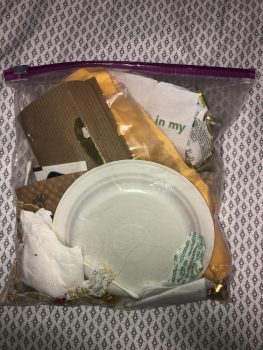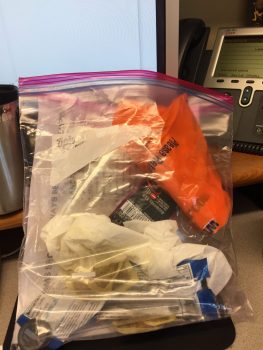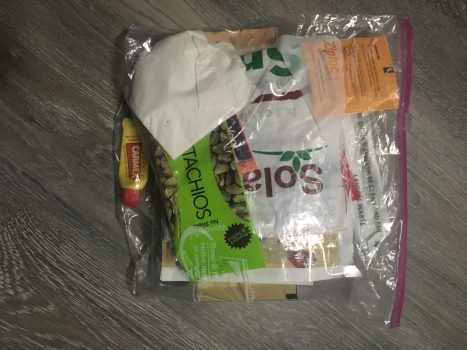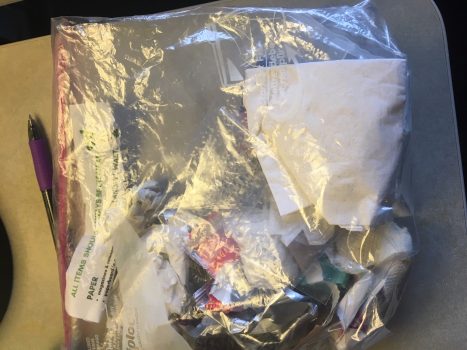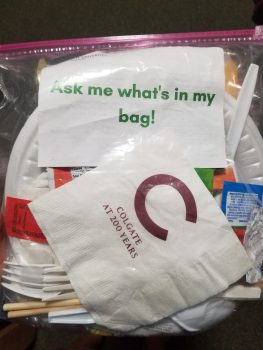This year marks Colgate’s tenth consecutive greenhouse gas inventory report. Colgate’s gross campus carbon emissions in Fiscal Year 2018 (July 1, 2017 to June 30, 2018) was 9,464 metric tons of carbon dioxide equivalent (MTeCO2). We have reduced our net campus carbon footprint by 12,332 MTeCO2, representing a 72.9 percent reduction since 2009. Since signing the American College and University Presidents’ Climate Commitment (ACUPCC) in 2009, rebranded as Second Nature’s Carbon Commitment, Colgate has implemented many changes on and off campus to achieve these reductions, moving closer toward our goal of carbon neutrality. 2018 State of Sustainability Report.
Latest Posts
Carry Your Trash Week
By Sustainability Office on February 27, 2019February 10-16 was a garbage week for some people at Colgate.
To bring awareness to the amount of trash produced by individuals on Colgate’s campus on a daily basis, 34 students and 8 faculty and staff members carried their trash with them for a week.
Throughout the week, participants opted to dispose of their waste in a Ziploc bag instead of a trash can. All trash produced during the week, except for hygiene products and food waste due to health and safety concerns, was carried in the bag and was visible for all to see. Many bags were completely full by the end of the seventh day, clearly demonstrating how much waste an individual can produce in a week.
Some of the most common items were food packaging, plastic silverware and food boats from the Coop, and paper towels. Participants say that they tried to limit the amount of trash they produced throughout the week, but many items, such as paper towels used to clean equipment in the gym, were unavoidable. According to one student, “I didn’t realize how many simple items are impossible to use without producing trash, especially food wrappers and containers.” About 50% of participants produced more trash than they originally anticipated.
Carry Your Trash Week has made students, faculty, and staff members more aware of the waste they produce. One student reported that “it is so easy to throw something away without thinking about it. Having to actively put it in a bag makes you much more conscious.” Additionally, Carry Your Trash Week has inspired people to change their behavior. Many students have committed to bringing reusable silverware up the hill and opting for a reusable mug instead of a disposable to-go cup.
In addition to compelling participants to face the amount of trash they produce in a week, another goal of Carry Your Trash Week was to encourage the entire Colgate community to think about their waste. However, despite participants’ best efforts to display the trash they were carrying, many did not receive questions or comments about their trash from others. One student reported that the only people who were willing to talk about reducing waste were already conscious of their own trash. According to Professor Jason Kawall, “I made sure [my trash bag] was highly visible in my classes but no one took me up on it, which was a little disappointing.”
Although overall campus engagement fell short of expectations, Carry Your Trash Week was still a great success, as many people on campus became more aware of the trash they produce and are taking action to consciously reduce their waste.
Sustainably Staying Warm
By Sustainability Office on February 18, 2019It’s no secret that Colgate students face quite a challenge staying warm during the frigid central New York winters. However, heating is incredibly energy intensive and greatly contributes to Colgate’s greenhouse gas emissions.

In 2017, over 50% of the university’s carbon emissions were associated with heating. Colgate’s heat comes from multiple sources including wood chips, natural gas, fuel oil, and kerosene. In order to heat campus as sustainably as possible, Colgate has recently made upgrades to campus infrastructure. For example, natural gas replaced fuel oil in the townhouses during summer of 2018. Although natural gas is a non-renewable resource, it is still much less carbon intensive than fuel oil. Additionally, the heating plant has recently been upgraded to support more efficient wood chip burning, which is a carbon neutral source of heat. These upgrades will help to reduce future carbon emissions.
While the university has taken steps to reduce carbon emissions associated with the operational side of heating, students can play a large role in reducing the amount of heating that is actually used. Here are some tips to help you both stay warm and decrease your carbon footprint on campus:
- Make sure all windows are closed when the heat is on
- Don’t turn your thermostat above 70 degrees
- Use a blanket and wear warm socks
- Lower the temperature a few degrees when you’re not in your room
- Wear warm winter clothes when you are outside to maintain a healthy body temperature so that you are not tempted to turn up the heat after returning inside
- Turn the thermostat down to 55 degrees if you won’t be in your housing for an extended period of time, such as over Spring Break
Establishing healthy heating habits now will also benefit you later in life when you’re responsible for paying your own heating bill. According to energy.gov, lowering the thermostat by 10-15 degrees for 8 hours per day will help you reduce your bill by 5-15% per year.
Heating is a necessary part of life, especially during the Spring semester at Colgate, but is unfortunately a large contributor to carbon emissions. Therefore, it is important to be mindful of how much energy we use to heat our rooms and do what we can to stay warm sustainably.
Meet the S-Reps
By Sustainability Office on February 14, 2019The Sustainability Representative (S-Rep) program introduces first-year students to the sustainability culture at Colgate and equips them with the skills and information they need to improve sustainable practices in their Commons communities. These are the 2018-2019 S-Reps!
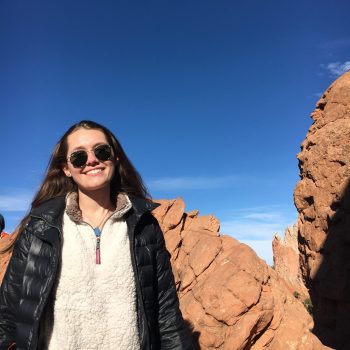
Ellie Lawrence is a Brown Commons S-Rep from Chicago, Illinois. She intends to double major in Political Science & Middle East/Islamic Studies. Ellie is involved with Club Ice Hockey & the Office of Admissions, and also enjoys skiing, working on political campaigns, and journalism. Ellie is passionate about making this campus a more environmentally-minded place.
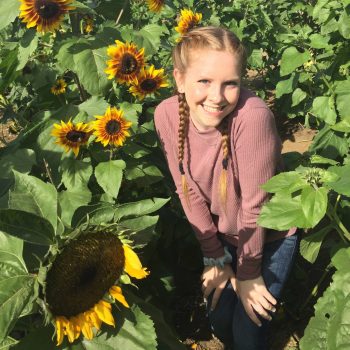
Juliana Koller is a Ciccone Commons S-Rep from Weston, Connecticut. Juliana intends to major in Environmental Studies. She enjoys being in Shock Dance Group and working at her sleep away camp in the Berkshires. Juliana is excited to help run events for Colgate’s 13 Days of Green.

Willa King is a Brown Commons S-Rep from New York, NY. She is an Economics major and is involved with the Hamilton Fire Department. Willa also enjoys baking and backpacking in her free time. She wanted to be an S-Rep because she has been fortunate to see some beautiful places in nature and wants to make sure those places can be preserved for future generations.
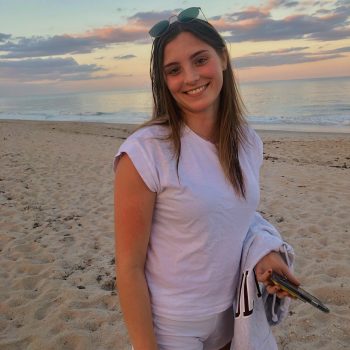
Nicole Dienst is a Ciccone Commons S-Rep from Westport, Connecticut. She intends to double major in English and Environmental Studies. Nicole is also a writer for the Maroon News, is on the Residential Commons Council, and is a member of Green Earth Gang. She is also an avid readers and enjoy hanging out with friends and playing sports. Nicole wanted to be an S-Rep so she could have real hands-on ability to improve sustainability at Colgate.
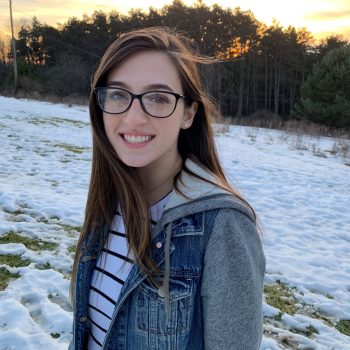
Kate Connelly is a Brown Commons S-Rep from Smithtown, New York. She intends to double major in Environmental Studies and Economics, and is also involved with Model United Nations and Hamilton Outdoor Group. In her free time Kate loves binge-watching Game of Thrones and quoting vines. She became interested in being an S-Rep because she wanted to be an advocate for change at Colgate.
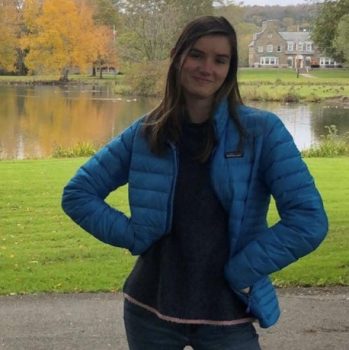
Melanie Crawford is a Ciccone Commons S-Rep from Atlanta, Georgia. She intends to major in Environmental Economics, and spends her free time partaking in Green Earth Gang, spending time outdoors, and hanging out with friends. Nicole wanted to become an S-Rep because she was interested in spreading awareness about the environment through events and campaigns.
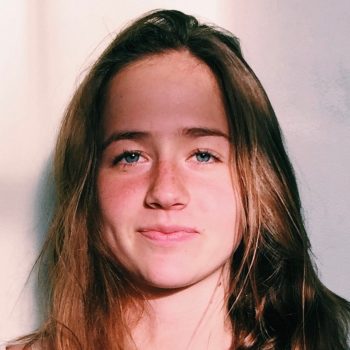
Ramy Berenblum is a Dart Colgrove S-Rep from Bedford, New York. She intends to major in Environmental Studies and is also involved in Sidekicks and Club Squash at Colgate. Ramy loves to hike and backpack in her free time. She is excited to be a role model for sustainability on campus.
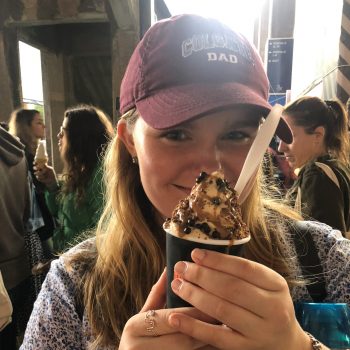
Clare McCormack is a Dart Colgrove Commons S-Rep who intends to double major in Sociology and Political Science. She is also involved with the Equestrian Team, Planned Parenthood Generation Action, and Spoon University. Clare is a firm believer that everyone can pitch in to keep the Earth inhabitable and beautiful for many generations to come.

Elisabeth Pezzuto is a Brown Commons S-Rep from Hilo, Hawai’i who intends to major in Biochemistry. Elisabeth spends her time on campus partaking in Outdoor Ed programs and dance programs. She also loves hiking, exploring new places, playing volleyball, and making ceramics. Elisabeth is very passionate about sustainable living and collectively doing small things that can make a big difference.

Sam Brotmann is a Brown Commons S-Rep from Pound Ridge, NY. He is currently undecided about his major. Sam is also involved in Students for Environmental Action and WRCU Radio at Colgate. In his free time, he enjoys playing bass guitar. Sam has always been interested in the natural world and living sustainably, and is excited for the opportunity to make Colgate a better place.
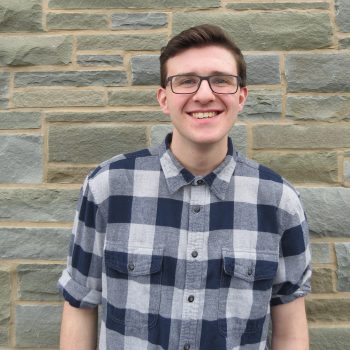
Liam Higgins is a Ciccone Commons S-Rep from Massapequa Park, NY. Liam intends to double major in History and Economics and is also a Mock Trial Attorney and Career Services Intern at Colgate. Liam loves listening to music in his free time. He was interested in becoming an S-Rep because he cares about the environment and promoting sustainability and taking every step possible to ensure that the Earth is habitable for generations to come.
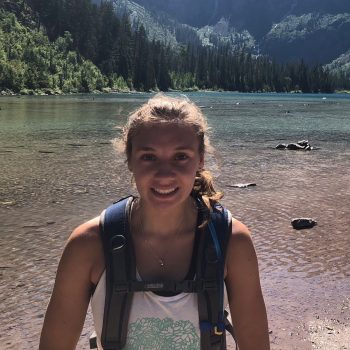
Charlotte Carey is a Ciccone Commons S-Rep from Balitmore, Maryland. She intends to major in Environmental Studies and is also in Club Squash and UCAN at Colgate. In her free time she loves to paint, learn about art history, and hike. Charlotte is so excited to learn more about the sustainable initiatives on campus and to be involved in making Colgate a greener school.
Carbon Emissions at Colgate and Beyond
By Sustainability Office on December 11, 2018Carbon emissions have recently been a hot topic of conversation both at Colgate and around the world. As the University engages in campus-wide conversations regarding carbon neutrality and carbon offsets, international reports on climate change emphasize the importance of mitigating carbon emissions.
On November 23, 2018, the US government released a National Climate Assessment Report. The scientific report, which was issued by 13 federal agencies, warned of the consequences of climate change. In addition to environmental degradation and threats to marginalized communities, America’s economy could be reduced by as much as 10% by the end of the century.
This report is one of many to have been recently released. In October, the IPCC released a report about an impending climate crisis, advising nations to take urgent action in order to limit global temperature rise to 1.5℃. Less than two months later, the UN released its annual Emissions Gap Report to check on how well countries are doing at reducing their greenhouse gas emissions. Alarmingly, global emissions currently are not on track to limit warming to 2℃.
While international communities are highlighting the importance of mitigating carbon emissions, Colgate is taking responsibility for its carbon footprint and is on track to become carbon neutral in 2019.
For students interested in learning about national climate assessments, four Colgate alumni who have worked on the National Climate Assessment Report will be on campus from Thursday, January 31 to Friday, February 1. The panelists are Ellen Mecray ’90, Director, Eastern Regional Climate Services, Center for Weather and Climate, U.S. Department of Commerce, NOAA; David Reidmiller ’01, Director, National Climate Assessment at the U.S. Global Change Research Program; Dan Barrie ’05, Program Manager with NOAA’s Climate Program Office and NOAA representative to USGCRP National Climate Assessment Steering Committee; and Natalie Bennett ’16, Adaptation and Assessment Analyst at the U.S. Global Change Research Program.
On Thursday evening, they will present The Climate Dilemma: Findings, Impacts, and Actions from the Fourth National Climate Assessment.
On Friday afternoon, they will present The Fourth National Climate Assessment: the Story behind the Report from Four Colgate Alumni.
Students and Staff Present at AASHE Conference
By Sustainability Office on October 19, 2018From October 2-4, three Colgate students and three staff members attended the AASHE Conference and Expo in Pittsburgh, Pennsylvania. AASHE, or the Association for the Advancement of Sustainability in Higher Education, hosts an annual conference attended by nearly two thousand people. The theme of this year’s conference was “Global Goals: Rising to the Challenge.” The conference gave attendees the opportunity to present their efforts to promote sustainability at Colgate as well as learn about successful projects at other universities.
“People come to AASHE to make change-inspiring strategies accessible to all. I witnessed people actively solving how to scale new systems within different geographical and cultural contexts. It was truly a privilege to learn from and alongside such innovative sustainable thinkers,” said UCan founder Christina Weiler ‘21.
Thanks to funding support from CLTR, students were able to attend AASHE and view presentations, network with sustainability professionals, and present the work they have done at Colgate. Isabel Dove ‘19, an intern with the Office of Sustainability and founder of the Beekeeping Club, was a panelist on a presentation entitled “Pollinator Friendly Campuses: Strategies to Help You Get Your Buzz on.” Isabel discussed student involvement with campus apiaries and gave advice for establishing apiaries at other institutions. Intern Madison Smith ‘19 and Christina Weiler ‘21 both served as panelists on “Sustainability-themed Living and Learning Communities,” in which they discussed Colgate’s innovative S-Rep program. Christina also presented a poster on her social recycling system UCan.
Sustainability and Environmental Studies Program Coordinator Pamela Gramlich co-lead the workshop “Develop Your Toolkit for Sustainability Communications.” Pamela and Kat Pritts, a designer for the Communications Office, both contributed to the presentation “Communication Strategies to Reach Beyond the Choir.” Finally, Director of Sustainability John Pumilio served as a panelist on the presentation “Approaches to Carbon Offset Procurement.” These workshops and presentations were an effective way of communicating Colgate’s leading-edge approaches to promoting sustainability on campus.
The AASHE conference served as a professional development opportunity for students and energized interns to continue thinking of ways to engage the Colgate community in sustainable lifestyles. Madison reflects, “While it was great to present at AASHE, gain experience in public speaking, and collaborate with people from other schools, the most valuable part of the conference was listening to the ideas of my peers and learning through the work that they are doing.”
Water Refill Stations Promote Environmental and Personal Wellness
By Sustainability Office on October 12, 2018By: Jaanvi Sachdeva ’21
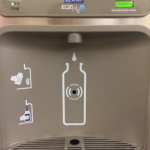
Colgate University is currently home to 16 state-of-the-art Elkay water refill stations, and is on the path to installing more. This cleaner, more energy-efficient water experience is something that students have come to understand as part of their lives, but they have not been around forever.
The University has installed these water refill stations in several batches, with each new addition following student backing and request. In 2015, a refill station was installed in the renovated Cooley Science Library, and in 2016, four were installed on the first, third, fourth, and fifth floors of Case-Geyer. Many of these projects have been the direct result of SGA proposals that highlighted the essential role the stations could play in encouraging sustainable behavior and showcasing sustainable living at Colgate. Bryan Complex just received an Elkay water refill station thanks to a successful SGA proposal, and 113 Broad is expected to receive one before 2019.
Students have expressed that these stations significantly benefit their lives, as they promote both sustainable behaviors and regular hydration. “I think I drink much more water here [at Colgate] than I do at home, because every time I walk by one of those stations, I am reminded to fill my bottle up. At home if I’m thirsty, I just grab a plastic water bottle but I regularly use a reusable bottle while here,” said Jared Collins ’21.
The Elkay water refill stations leads to a wider acceptance and normalization of reusable water bottle use. This is important because last year, the average American used 167 disposable water bottles, but only recycled 38, leading to significant environmental harms. The Elkay water refill stations not only save money spent on disposable water bottles and add convenience to the lives of students, but also decrease waste associated with single-use bottle production and disposal.
While more widespread use of reusable water bottles by Colgate students has been encouraged by the Elkay water refill stations, there is still room for improvement. Perhaps the largest obstacle to reducing plastic waste is that many students do not feel comfortable drinking the tap water here and consequently opt to drink bottled water. One student reports, “It’s convenient to keep plastic bottles in the room, because I’m unsure about the quality of the tap water. It doesn’t taste as good as water from other places.” While Colgate’s tap water is safe to drink and is regularly tested for safety, the Elkay stations do provide students with another, better-tasting option to refill their bottles.
While Colgate is making great strides to encourage healthy, sustainable lifestyles and reduce waste, we can still do much more! If students are passionate about these issues, some outlets for these concerns might be talking to Commons leaders, seeking funding from various student groups, or simply putting their concerns in the public eye where decision-makers are aware of them. We encourage student participation in this conversation for greater sustainable living!
The locations of the current Elkay refill stations at Colgate can be viewed here:
Application now open for the 2018-2019 Colgate Community Garden Internship!
By Sustainability Office on July 24, 2018The Office of Sustainability is pleased to announce that applications for the 2018-2019 Community Garden Internship are now open! Founded in 2010 from the efforts of a group of ENST 480 students and the Class gift of 2010, the Colgate Community Garden is now a half-acre vegetable and herb garden. We are looking for qualified students to help our Garden Manager, Beth Roy, not only manage and promote the garden, but also coordinate and organize volunteers and student work parties.
Garden interns should expect having to work in physically demanding, yet rewarding, conditions such as exposure to the outdoors and having to perform physically taxing activities. The internship has enabled past student garden interns to gain life-long skills and knowledge in harvesting and garden maintenance, event organization, and volunteer workers supervision.
“I’m very excited to see plants I planted grow and change through the course of the summer,” said Summer Cardarelli’21, one of the Summer 2018 Community garden interns, when she started working at the garden. Andrew Lapp’20, another Summer 2018 garden intern stated that assembling a caterpillar tunnel where they planted eggplants and tomatoes was a very enjoyable experience, and he thinks being a garden intern is ideal if you enjoy the outdoors.
The internship program involves a paid position starting around August 28th 2018 until early November 2018. Students of all class years and majors are welcome to apply. The expected work hours are 6 hours weekly. To apply, applicants should email their resume and a one-page cover letter (required), to Beth Roy, the Garden Manager at eroy@colgate.edu, and fill out the application on the Colgate Portal.
The application deadline is Friday, August 10th.
See the full job description below:
INTERNSHIP OVERVIEW AND PRIMARY RESPONSIBILITIES:
Interns will:
- Work with garden manager (Beth Roy) to plan and manage the garden during the fall season. Specific tasks may include preparing soil, cultivating, planting, weeding, and harvesting.
- Organize and supervise volunteer work parties.
- Coordinate with Green Thumbs presidents to schedule a weekly time for volunteer work parties and be at the garden during those scheduled times to supervise the work parties.
- Provide continuity for work on the garden throughout the 2018 growing season.
- Prepare for and help run a weekly Farm Stand to sell produce from the garden.
REQUIRED SKILLS AND EXPERIENCE
- Strong work ethic and self-motivated.
- Strong interpersonal and communication skills.
- Preference will be given to those with experience and firsthand knowledge in farming and/or gardening with vegetable crops; though previous garden experience is not required.
- Experience organizing and supervising the work of others.
- Tolerance for hard work and exposure to outdoor elements.
- Excitement about promoting local farming and local food production
For more information, visit the Colgate Portal or contact Beth Roy (eroy@colgate.edu), the Colgate Community Garden Manager and Consultant, or John Pumilio (jpumilio@colgate.edu) the Director of Sustainability.
Educational Agriculture at Morrisville State College
By Sustainability Office on July 13, 2018-Summer Cardarelli ’21 and Andrew Lapp ’20
At the end of May, the garden team along with the sustainability interns took a tour of the Morrisville State College 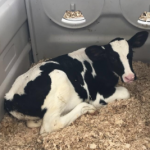 Agriculture department in order to learn more about the methods used by a more agriculture centered school. We had the opportunity to visit Morrisville’s Dairy Complex, its greenhouse, its aquaponics buildings, as well as the Spader Horticulture Complex. On this tour, we were able to learn a lot about the techniques used by the college to maintain such a successful agriculture department. Much of what we observed, especially in their greenhouse, could be relevant to our own garden.
Agriculture department in order to learn more about the methods used by a more agriculture centered school. We had the opportunity to visit Morrisville’s Dairy Complex, its greenhouse, its aquaponics buildings, as well as the Spader Horticulture Complex. On this tour, we were able to learn a lot about the techniques used by the college to maintain such a successful agriculture department. Much of what we observed, especially in their greenhouse, could be relevant to our own garden.
The Dairy Complex at Morrisville State College is home to 220 cows, each of which are milked three times a day. As each cow can eat around 120 to 150 pounds of food a day, 100 pounds of milk per cow can be expected daily. The goal is for each cow to have at least one calf every year so that they can keep producing milk. If a cow is not producing milk, it is sold for beef. Male calves are also sold immediately, as they cannot produce milk. There is now new technology that allows farmers to sex the bull’s sperm to nearly guarantee either a male or female calf.
 Though the Dairy Complex aims to operate as similarly to a regular dairy farm as possible, it is inhibited by the increased cost of running the facility versus a traditional complex. As the Morrisville Dairy Complex focuses on providing an educational experience for its students, it does not generate a large profit, making it more expensive to operate. The cost aside, the Dairy Complex is able to offer its students enriching hands-on experiences in and out of the classroom, including lessons on milking and breeding the cattle. The next step for the complex depends upon the approval of a grant which would allow the introduction of robotic milking machines to the facility, increasing the efficiency of the milking process with the most modern technology.
Though the Dairy Complex aims to operate as similarly to a regular dairy farm as possible, it is inhibited by the increased cost of running the facility versus a traditional complex. As the Morrisville Dairy Complex focuses on providing an educational experience for its students, it does not generate a large profit, making it more expensive to operate. The cost aside, the Dairy Complex is able to offer its students enriching hands-on experiences in and out of the classroom, including lessons on milking and breeding the cattle. The next step for the complex depends upon the approval of a grant which would allow the introduction of robotic milking machines to the facility, increasing the efficiency of the milking process with the most modern technology.
Next, we visited the high tunnel greenhouse at Morrisville, which produces many varieties of produce to be sent to the 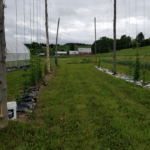 campus’s two dining halls or donated to the community. Crops such as garlic, onion, hops, watermelon, and many types of flowers are also grown in the area outside of the greenhouse. An electric fence prevents deer from reaching the crops, and plastic is placed around each of the plants to prevent bugs, weeds and other pests from taking over the area. The goal of the greenhouse is to be able to profit from the crops grown there, though the value of educational experiences for their students and interns is of the utmost importance.
campus’s two dining halls or donated to the community. Crops such as garlic, onion, hops, watermelon, and many types of flowers are also grown in the area outside of the greenhouse. An electric fence prevents deer from reaching the crops, and plastic is placed around each of the plants to prevent bugs, weeds and other pests from taking over the area. The goal of the greenhouse is to be able to profit from the crops grown there, though the value of educational experiences for their students and interns is of the utmost importance.
Morrisville’s aquaponics greenhouses combine the practices of hydroponics and aquaculture to fertilize plants grown using hydroponics with the waste of fish which are farmed with aquaculture. The Aquaponics Closed 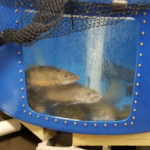 Environment Greenhouse is one of the central buildings in the aquaponics complex, containing paddlefish and different crops of vegetables and herbs to be grown. Water from the paddlefish tanks is transported to filtration systems, which remove uneaten food, solid fish waste, ammonia and other particulate matter from the water before sending it back to the fish and plants. The nitrates present in the water serve as a fertilizer for the plants, creating a closed and sustainable system of agriculture.
Environment Greenhouse is one of the central buildings in the aquaponics complex, containing paddlefish and different crops of vegetables and herbs to be grown. Water from the paddlefish tanks is transported to filtration systems, which remove uneaten food, solid fish waste, ammonia and other particulate matter from the water before sending it back to the fish and plants. The nitrates present in the water serve as a fertilizer for the plants, creating a closed and sustainable system of agriculture.
To breed Brook Trout, one of many breeds of fish used in the aquaponics complex, Morrisville students get the hands-on experience of using anesthesia on the fish, stripping them of eggs and sperm, then combining the two in a bowl which they add water to in order to activate the sperm. They then incubate the eggs until they are ready to hatch. This method of breeding the trout assures a higher efficiency than leaving the fish to breed on their own.
The Spader Horticulture Complex contains all of the classes a horticulture student will take in a day. It is important to their curriculum that the courses are all in close proximity so that the lesson may be fortified with hands-on experience; for  example, something covered in the lecture hall can be further instructed in one of the design studios. Horticulture students are all required to take design courses, including a course on floral arrangements. The complex is home to many varieties of flowers and plants, including types that are not normally found in Upstate New York, such as cacti and citrus plants. The experiences of horticulture students at Morrisville State College comes together holistically in a hands on project, such as designing a yard or patio to be built for someone in the community.
example, something covered in the lecture hall can be further instructed in one of the design studios. Horticulture students are all required to take design courses, including a course on floral arrangements. The complex is home to many varieties of flowers and plants, including types that are not normally found in Upstate New York, such as cacti and citrus plants. The experiences of horticulture students at Morrisville State College comes together holistically in a hands on project, such as designing a yard or patio to be built for someone in the community.
The lessons, strategies and techniques we learned during our visit to Morrisville’s agricultural facilities are relevant to our own garden at Colgate University. Our visit to the greenhouse at Morrisville, for example,  helps us brainstorm solutions for different constructs we could build at the Community Garden for the cultivation of plants. Though our own greenhouse unfortunately collapsed due to a winter storm, our newly constructed caterpillar tunnel serves as a temporary solution and allows us to grow tomatoes, eggplant, peppers and basil in a hot, covered environment. The future of a greenhouse in the Colgate Community Garden, however, could be inspired by the innovations we witnessed at Morrisville State College. This summer, we also hope to add a hydroponic system to the garden, so our tour of the Aquaponics Closed Environment Greenhouse was a valuable experience. Though aquaponics makes use of aquaculture in addition to a hydroponic system, some of the same lessons translate over to us in preparation for our own future hydroponics system. Despite Morrisville’s agriculture department having facilities on a much larger scale than we have here at Colgate, the observations we made during our visit are still of great use to us as we pursue both new additions and our usual routine back at the Community Garden.
helps us brainstorm solutions for different constructs we could build at the Community Garden for the cultivation of plants. Though our own greenhouse unfortunately collapsed due to a winter storm, our newly constructed caterpillar tunnel serves as a temporary solution and allows us to grow tomatoes, eggplant, peppers and basil in a hot, covered environment. The future of a greenhouse in the Colgate Community Garden, however, could be inspired by the innovations we witnessed at Morrisville State College. This summer, we also hope to add a hydroponic system to the garden, so our tour of the Aquaponics Closed Environment Greenhouse was a valuable experience. Though aquaponics makes use of aquaculture in addition to a hydroponic system, some of the same lessons translate over to us in preparation for our own future hydroponics system. Despite Morrisville’s agriculture department having facilities on a much larger scale than we have here at Colgate, the observations we made during our visit are still of great use to us as we pursue both new additions and our usual routine back at the Community Garden.
Overwhelmed by Plastic: Participating in Plastic Free July 2018
By Sustainability Office on July 12, 2018-Marielle Scheffers ’19
 Plastic is ubiquitous. In saying this, I am not making some earth-shattering statement. Even if you spend very little time thinking about or engaging with sustainability you are most likely aware of the very present problem of plastic in our environment. Notoriously undegradable, plastic has been found everywhere from the summit of Mt. Everest to the depths of the ocean and everywhere in between. Plastic is not just problematic after it is used but also during its creation. A major component in creating plastic is crude oil which is heated and refined to separate out the specific molecules required to form plastic. As a response to the numerous problems associated with plastic consumption, Plastic Free July was organized. Plastic Free July promotes the elimination of all plastic use, but especially focuses upon one-time use plastic. As a part of Plastic Free July, I decided that for a single weekend I would document all my plastic use, from one time use plastic like plastic bags to multiple use plastic like my reusable water bottle that I have owned since my first year of highschool, to better understand to what extent plastic is a part of my daily life.
Plastic is ubiquitous. In saying this, I am not making some earth-shattering statement. Even if you spend very little time thinking about or engaging with sustainability you are most likely aware of the very present problem of plastic in our environment. Notoriously undegradable, plastic has been found everywhere from the summit of Mt. Everest to the depths of the ocean and everywhere in between. Plastic is not just problematic after it is used but also during its creation. A major component in creating plastic is crude oil which is heated and refined to separate out the specific molecules required to form plastic. As a response to the numerous problems associated with plastic consumption, Plastic Free July was organized. Plastic Free July promotes the elimination of all plastic use, but especially focuses upon one-time use plastic. As a part of Plastic Free July, I decided that for a single weekend I would document all my plastic use, from one time use plastic like plastic bags to multiple use plastic like my reusable water bottle that I have owned since my first year of highschool, to better understand to what extent plastic is a part of my daily life.
As I began to embark upon the weekend, I started to think about what areas of my life utilize a large volume of plastic. The first thing that came to mind was each and every bathing and self-care product I use is neatly packaged in a shiny, brightly colored plastic packaging. The second was the plastic produce bags used at the grocery store to purchase vegetables, my refrigerator is full of them. Those two things seemed to be the major offenders, but other than that, I approached the weekend believing that while there were parts of my life that plastic had a large presence, plastic use was not incorporated in every aspect of my life. I was wrong, very wrong.
After documenting and examining my weekend plastic use, I will detail the main results here. I will specifically focus on Saturday morning because of the similarity between my plastic use on Saturday morning to the rest of the weekend.
Saturday
7:45am
- I wake up and put my hair up with a plastic hair tie that I got as a present. Yes, a plastic hair tie, this weekend could have started on a better foot.
- Enter self-cleaning routine, as a suspected earlier everything is packaged in plastic. Bathing is composed of utilizing items that are so regularly used that we hardly notice them anymore: shampoo, conditioner, soap, toothpaste, a toothbrush, lotion, and list goes on. If you wear makeup, this list is even longer. These items vary in their ability to be recycled. Most toothpaste tubes, toothbrushes, and makeup packaging are composed of one-time use packaging. Shampoo, conditioner, and soap bottles are usually recyclable; however, even if they are recyclable, fossil fuels are still required to create the packaging and then again later to create the energy to recycle the product. It is better to not use the plastic at all.
- I get dressed, putting on t-shirt and leggings. The t-shirt is 100% cotton, but the leggings are polyester. Polyester is really just plastic in disguise, so like most plastic it is composed of petroleum.
8:50am
- Breakfast at Flour and Salt, where I need a spoon to eat my oatmeal. I grab on of the plastic spoons they provide. Well, it is just one more piece of plastic to add to my exponentially growing list. The spoon does state that it is compostable plastic. Compostable plastic is a newer type of plastic that is often composed of a renewable material. The most popular material is corn. Compostable plastics are capable of degrading in a commercial composting facility where the temperatures can get quite high.
9:30am
- I buy vegetables from the farmers market, which are given to me in a plastic produce bag. I thank the farmer and then place the bag in my reusable shopping bag and laugh at the paradox that is placing a plastic bag inside a reusable bag.
1:00pm
- As I open my fridge to make lunch, I notice the volume of plastic in my fridge. It is very possible that there is more plastic in my fridge and pantry, than there is food. Vegetables are stored in plastic produce bags, condiments like ketchup and peanut butter are in plastic bottles, and leftovers are stored in plastic tupperware. Because of this, every meal I prepare for myself throughout the course of the weekend utilizes a large amount of plastic. Even my cutting board is made of plastic.
Before this weekend I thought I had a general grasp on how much plastic one uses daily, but really, I had grossly underestimated what my plastic use is. There is not an aspect of my life that does not include plastic consumption. I acknowledge that every person’s plastic use varies, so the plastic use I have detailed here will not be identical to your own. However, I hope that through reflecting upon my own plastic use, it will encourage you to examine your own.
There are a number of ways one can decrease their plastic use. An important place to start is by focusing on single-use plastic. In my own case, as a result of this weekend, I replaced the plastic produce bags that hold my vegetables with reusable bags and replaced my toothbrush with a bamboo toothbrush. Other easy options are to start using reusable shopping bags instead of plastic bags, to use a bar of soap instead of a bottle, and to stop using plastic water bottles in favor of a water filter and a reusable water bottle. Bonus points if your reusable water bottle is metal or glass. While it is easy to get excited about eliminating all plastic in your life and begin replacing every plastic item that you own with a nonplastic substitute, this is not necessarily sustainable either. For example, in the case of the plastic tupperware I use, it is multi-use plastic. I already own the tupperware. Recycling it and replacing it with a nonplastic option, while decreasing the amount of plastic I use in my daily life, will only increase the amount of unnecessary waste I produce. For multi-use plastic items, it is better wait until the end of their lifespans to replace them with a non-plastic alternative. Finally, when analyzing your daily plastic use remember the 4Rs. First, refuse to use any unnecessary plastic, then try reducing your use of plastics that are more difficult to refuse, after reuse any other remaining plastic, and finally as a last resort recycle it.




